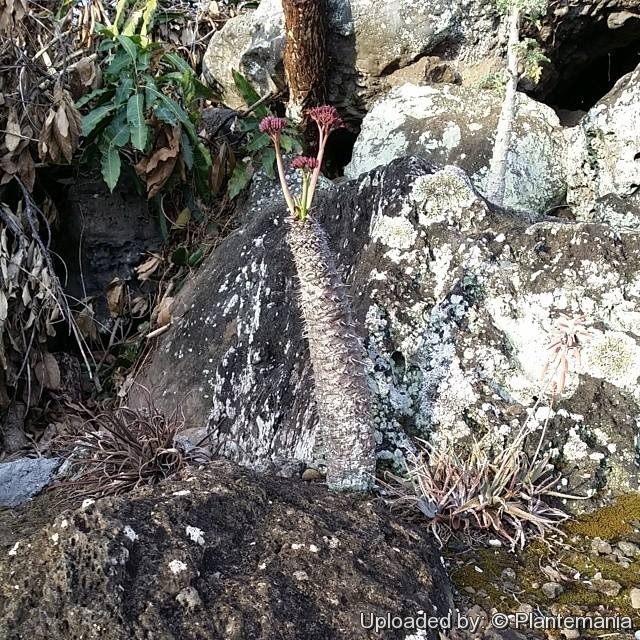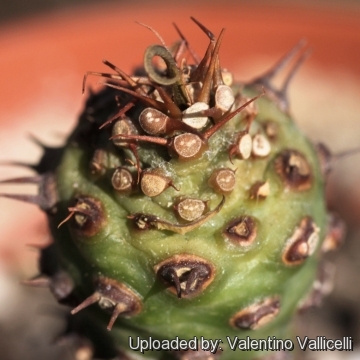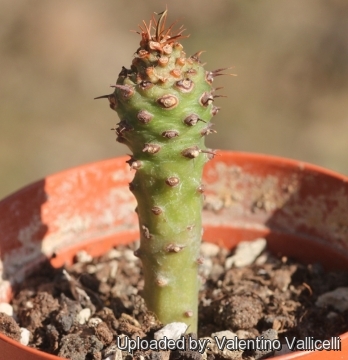




Your support is critical to our success.
- Encyclopedia of SUCCULENTS
- Encyclopedia Index
- Families
- Genera
- Species
- Euphorbiaceae
- Euphorbia
- Caudiciforms
Since 4 Aug 2013

Origin and Habitat: Northern Madagascar. Euphorbia pachypodioidesSN|23187]]SN|25960]] is restricted to the Tsingy of Ankarana reserve and is not known from anywhere else (Area of occupancy 7.8 km²).
Habitat and Ecology: It grows on steep rock faces on Tsingy limestones where thousands of these plants occur. The low-growing species Euphorbia aureoviridifloraSN|25965]]SN|25962]], Euphorbia herman-schwarzii, Euphorbia viguieri and Euphorbia neohumbertiiSN|25962]]SN|25965]], and the larger species Euphorbia tirucalliSN|25960]]SN|23187]], also occur in this area. Major threats are habitat degradation, fire, collection for the horticultural trade. The continuing decline qualifies it for Critically Endangered.
Synonyms:
- Euphorbia pachypodioides Boiteau
Euphorbia pachypodioides Boiteau
Bull. Acad. Malgache n.s., 24: 87 1942.
Synonymy: 2
- Euphorbia pachypodioides Boiteau
- Euphorbia antankara Leandri
Description: Euphorbia pachypodioidesSN|25960]]SN|25960]] is a highly desirable species with high horticultural appeal. It forms short pachypodium-like stems with attractive bright red cyathia at the top and bright frosted blue leaves.
Habit: It is a winter deciduous succulent subshrub, usually unbranched, 35-50(-70) cm tall.
Stem: Simple, columnar, 5(-8) cm in diameter at the base, spiny, green or dark purple with a bluish tint and covered with prominent leaf-scars in 8-12 spiral series.
Stipular Spines: Isolate and single, reddish-brown becoming dark purple, about 1.5 cm long, with expanded bases, eventually breaking off.
Leaves: Large clustered at stem tip, elliptic to lanceolate, to 10-12 cm long 3-5 cm wide, apex acute, upper face glaucous-green, lower face red-violet, subsessile (petiole short and thick) and deciduous. The leaves start appearing in late winter.
Inflorescences (Cymes): Several at stem tip, branched (mostly 6- forked) on peduncles up to 8 cm long each bearing 20-40 cyathia.
Cyathophylls: Erect, apiculate, dark-purple, green at the base, enclosing and hiding the cyathia-involucrum, 4-5 mm long and 2-3 mm wide.
Cyathia: Subsessile, erect, about 2.5 mm in diameter, purplish. Lamele flowers protruding from Cyathophylls with yellow anthers.
**Nectar glands: Yellowish and small.
Ovary: Ovoid, obtusely lobed, purplish, sessile, pistil styles purple united for half their length, stigmas bifid purple.
Blooming season:*** In its natural habitat this species blooms in the late dry season, before the leaves appear in December at the beginning of the rainy season.
Bibliography: Major references and further lectures
1) Haevermans, T. 2004. Euphorbia pachypodioides. In: IUCN 2013. "IUCN Red List of Threatened Species." Version 2013.2. <www.iucnredlist.org>. Downloaded on 20 January 2014.
2) Urs Eggli “Illustrated Handbook of Succulent Plants: Dicotyledons” Volume 2. Springer, 2002
3) F. Polz, “Euphorbia pachypodioides” P. . Drinking in: Kakteen und andere Sukkulenten 43 (6): Central page peel No. 19 (both sides) 1992
4) Hilary Bradt “Madagascar” Bradt Travel Guides, 2011
5) Rauh W., "Succulent and xerophytic plants of Madagascar" 1: 301-303, figs. 890-896 Strawberry Press, 1995

Euphorbia pachypodioides Photo by: Valentino Vallicelli

Euphorbia pachypodioides Photo by: Valentino Vallicelli
Cultivation and Propagation: Euphorbia pachypodioidesSN|25960]]SN|25960]] is an attractive, but slow growing species available from several sources for enthusiasts. It has the fame to be quite tricky to cultivate.
Growth rate: It is a slow growing long lived plant and once established, it will be content in its position and with its soil for years.
Exposure: A very very light and warm place in full sun is highly appreciated, but can tolerate moderate shade, and a plant that has been growing in shade should be slowly hardened off before placing it in full sun as the plant will be severely scorched if moved too suddenly from shade into sun.
Soil: It does best in a mineral soil, good drainage is essential.
Watering: Water sparingly during the summer months and keep dry in winter. In the short growing season it likes ample water and in this period it grows rather quickly, though not for a long time. When not in growth it is killed right away, when given too much water.
Frost Tolerance: Tender, it needs frost protection. Recommended minimum temperature is 12 °C or even above.
Propagation: It is propagated from seed sown during spring or summer or by grafting stem.. Germination occurs within 3 weeks. Sowing seed of this self fertile species is the surest method of growing typical offspring and seedlings are in the first season relatively easy to grow. It can be grafted as well.
Grafting: The plants that are grafted on a more vigorous and easier stocks are easier to keep, grow faster and produce more flowers and seeds. The method of grafting euphorbias differs little from that of other succulents, except in one important aspect. The latex must be washed or sprayed off until hardly anything remains. After the latex flow has stopped, a further 1-2 mm slice can be taken from both surfaces without a new latex flow starting. Both scion and stock need to be at the start of the growing season. The stock should be cut as near as possible to the growing tip, as here the vascular bundles are dense and not yet woody and will feed the scion in the best possible way. Where possible stock and scion should be of similar diameter. The cut surfaces are held together with elastic bands in cross style, over the plant top and under the pot. The plants should be left in an airy and shady place for 7-10 days before the bands are removed.
Warning: As with all other Euphorbias when a plant get damaged it exudes a thick white milky sap known as latex. This latex is poisonous and particularly dangerous for the eyes, skin and mucous membranes. So pay extreme attention not to get any in your eyes or mouth. Cultivated plants must be handled carefully.
| Your Actions | |
|---|---|
| Back to Euphorbia index | |
| Back to Euphorbiaceae index | |
 |
Back to Succulents Encyclopedia index |
Privacy stantement - Terms and conditions - How to cite - About us - Feedback - Donate




